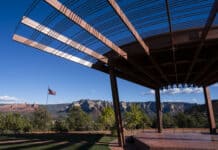The Sedona City Council discussed Wednesday how the city awards the contract for destination marketing and tourism promotion to the Sedona Chamber of Commerce.
Every few years when the contract comes up for renewal, a handful of anti-chamber naysayers who fail to understand or willfully and intentionally ignore the benefits of the chamber/city contract try to persuade council members there is some cheaper way to get the same results.
Bottom line: There isn’t. The chamber works wonders with money it receives from the city.
The first option was to move forward with the negotiation of a new contract with the Sedona Chamber of Commerce, basically a renewal of the current contract. After two hours of discussion, council unanimously approved this option, but for the sake of argument, let’s discuss the flaws and illogic of the other four:
- Issue a request for proposal for tourism promotion services.
If the chamber was a run-of-the-mill business and not a 501(c)(6) nonprofit, then an RFP would make sense. However, as a nonprofit, the chamber has considerable advantages over potential for-profit competitors, most obviously its dozens and dozens of unpaid volunteers who speak with thousands of tourists, offering recommendations for places to eat, shop, tour or stay the night. A for-profit business would have to pay staff, who would number far less and reach fewer tourists.
Even if the council were to give the tourism contract to a new third party, the chamber is beholden to its member businesses to provide tourism marketing and that obligation would not disappear just because of a City Council decision. Thus, the chamber would still be doing its work to attract tourism. - Create a stand-alone destination marketing organization without any ties to the Sedona Chamber of Commerce.
Whatever this would be called, it would basically be the “Sedona Chamber of Commerce and Tourism Bureau Mk. II,” performing all the redundant activities the current chamber does. It would not be a “competitor,” in the parlance of our times, as its goals would be the same — to bring tourist dollars to Sedona.
Tourist attraction is not a zero-sum game. Whether a tourist from Phoenix or Scranton, Pa., visits Sedona because of an ad produced by Chamber-prime or Chamber Mk. 11 or one of the city’s businesses acting on its own, the source would be immaterial to the city’s tax coffers and taxpayers.
The two chambers would likely collaborate on efforts anyway, just as the other chambers in the Verde Valley work with Sedona to attract tourists to the region. Thus, to avoid wasting money on duplicate efforts, there need only be one chamber entity.
The vast majority of chamber member businesses are mom-and-pop operations with a single storefront, perhaps two, not subsidiaries of international conglomerated mega-corporations. - Create a city department to handle tourism promotion.
Sedona is not some major metropolis that can open and run new huge departments on a whim with tens of millions of dollars allocated for new enterprises.
A new department would be entirely dependent of municipal funds, meaning less taxpayer money would be available for parks, police, roads and public works. It would also likely be staffed at first by just a handful of current employees who would have to learn the ropes of attracting tourists or by new employees the city would have to hire, train and acclimate to Sedona.
As a 501(c)(6) nonprofit, the chamber uses a mix of donated funds, dues from members and city funding via contact to operate, giving it far more financial resources to maintain its operations and bring tourist dollars to Sedona’s economy. - Issue a Request for Qualifications for a travel consultant to assess the current structure and funding and provide recommendations to the city.
While this seems like a good idea, there are already other outside consultants already doing this work, some of which are public bodies. In July we reported on a study by the Regional Economic Development Center at Yavapai College revealing that for every $1 invested in the Sedona chamber’s efforts, visitors spent $39.65. Of that, $8.19 went to the city via taxes.
Studies by other institutions and agencies regularly discover similar numbers, so it’s unclear why the city should waste tax money to hire an outside firm to run a study producing similar results.
The Sedona City Council wisely ignored the grumblers and unanimously decided not to “fix” a mutually beneficial agreement.


















